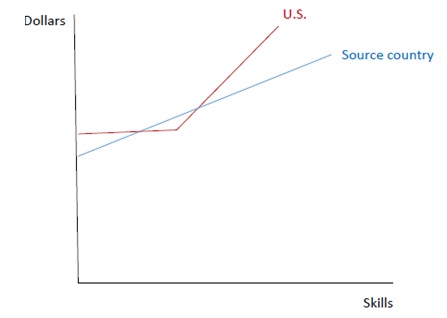Assignment:
1. Suppose a worker currently resides in Dayton, OH and is deciding whether to remain there or move to Chicago, IL. In real wages, he will earn $20,000 per year for each of the next 3 years left in his working life if he stays in Dayton, OH. If the worker moves to Chicago, he will earn $22,000 in real wages per year for each of the next 3 years left in his working life. Note that real wages have already accounted for differences in the cost of living. Assume there are no yearly costs to consider since we have already accounted for differences in cost of living. The worker faces a real interest rate of 5%.
(a) What is the highest one-time cost of the move (including direct and psychic costs) for which the worker is still willing to migrate from Dayton, OH to Chicago, IL? Briefly explain your answer.
(b) Now consider a much younger worker who has 30 years left in his working career. Every- thing else is the same as described above. Without doing any additional calculations, state whether you would expect the highest one-time moving cost at which this worker is still willing to migrate from Dayton, OH to Chicago, IL to be larger or smaller than the moving cost calculated in part (a). Briefly explain your answer.
2. Consider an existing wage differential between two regions.
(a) Briefly explain and illustrate how this wage differential is reduced via movements of capital between the two regions. In particular, specifically state whether capital flows to or from the low-wage area.
(b) Briefly explain and illustrate how this wage differential is reduced via movements of work- ers between the two regions. In particular, specifically state whether workers migrate to or from the low-wage area.
3. Consider immigrants coming from an east Asian country to the United States. Suppose the east Asian country currently has more income inequality than the U.S. at low levels of income and less income inequality (lower returns to skills) at the upper end of the distribution. This could be achieved if, for instance, the U.S. labor market offers higher returns to skills at the upper end but also provides an income safety net through welfare programs at the lower end of the earnings and skill distribution. The scenario is illustrated below.

(a) Use the figure above to identify the skill-level of the immigrants who will enter the U.S. from this east Asian country. Briefly explain why this is the case.
(b) What type of selection is occurring in the type of immigrants coming to the U.S. from this east Asian country? Briefly explain your answer.
4. Suppose years of schooling, s, is thought to be the only variable that affects earnings. The weekly salaries of male and female workers are given by the following equations, where wm represents male wages and Wf represents female wages.
Wm = 12 + 2.5s
Wf = 10 + 2s
On average, men have 14 years of schooling and women have 12 years of schooling.
(a)What is the average male-female wage differential in the labor market?
(b) Using the Oaxaca decomposition, calculate how much of this wage differential is due to discrimination. Briefly explain how we should interpret this result.
(c) Briefly discuss why this measure might not accurately state the effects of gender-discrimination in the labor market? Would you expect the measure of discrimination found in part (b) to overstate or understate the level of gender-discrimination in the labor market? Briefly ex- plain your reasoning.
5. Suppose a firm's production function is given by q = 10 ∗ ,Ew + Eb where Ew represents the number of white employee-hours and Eb represents the number of black employee-hours. It can be shown that the marginal product of labor is
MPE = √[5/(Ew+ Eb)]
Suppose the equilibrium market wage for black workers is $10 per hour, and the equilibrium market wage for white workers is $15 per hour. The price of each unit of output is $60. Black and white workers are substitutes in this production function, meaning that the quantity of output only depends on the total quantity of labor (Ew + Eb). Note, Profits = Total Revenue - Total Cost = P ∗ Q - (Wb ∗ Eb + Ww ∗ Ew).
(a) How many worker-hours of each type would a nondiscriminatory firm hire at the equilib- rium wage rates listed above. How much profits does this nondiscriminatory firm earn, assuming wages are the only cost incurred by this firm?
(b) Suppose a firm discriminates against blacks with an employer discrimination coefficient of
0.2. How many worker-hours of each type does this firm hire? How much profit does this firm earn?
(c) Suppose a firm discriminates against blacks and has an employer discrimination coefficient equal to 0.6. How many worker-hours of each type does this firm hire? How much profit does it earn?
(d) Suppose a firm is nepotic and favors blacks so it has an employer nepotism coefficient of 0.4. (You can equivalently think of this as a discrimination coefficient equal to -0.4). How many worker-hours of each type does this firm hire? How much profit does it earn?
(e) Based on your answers above, briefly discuss the long-run implications of discrimination against or preferential treatment toward a specific racial group in a competitive labor market?